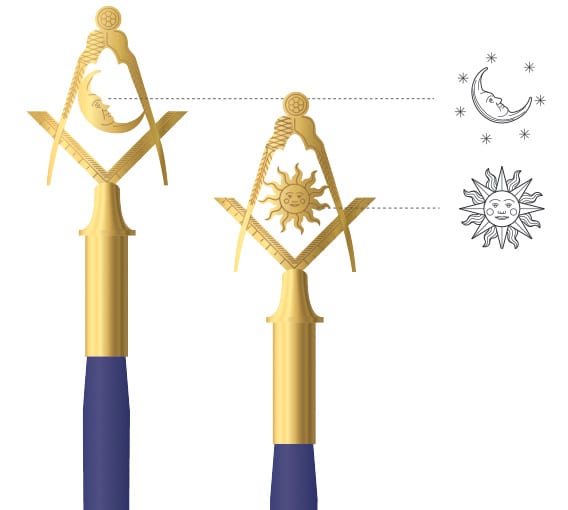
Creating a Culture That Unites
Junior Grand Warden Arthur H. Weiss explains the beauty and significance of Masonic material culture.
By Mark Frauenfelder
A 10-year-old boy is attending a family picnic in a park in some suburban neighborhood – outside Denver, perhaps, or San Francisco or Chicago. He is eating classic American food; hot dogs or fried chicken soaking through his paper plate. While taking a bite, he looks up at the man sitting across from him, who is talking to his grandfather. As the man lifts his hand to take a sip of his drink, the boy notices his unusual wristwatch.
The watch is unlike anything he has ever seen. It is gold and triangular with colorful symbols around the face where numerals would typically be. One of the symbols looks like a skull and crossbones. It’s practically comic book superhero stuff! The boy is too shy to ask about the watch, but he tries to visualize it as he rides home that evening, in the back seat of the family car. The next morning he wonders if he imagined the man and his mysterious watch.
Without realizing it, he has just had his first introduction to the material culture of Freemasonry.
“Material culture” is the sociological/anthropological term for the things and places associated with a group’s identity and culture. This includes dwellings, places of ceremonial gathering, workplaces, artwork, manufactured goods, food, books, walking paths, neighborhoods – basically everything you can see and touch in a physical location, including the location itself. By studying the physical elements a society uses, you can learn a great deal about the people in that society, because their material culture is closely related to their “nonmaterial culture”: the habits, beliefs, codes of ethics, and ideas they hold. And that’s because physical things are also symbols that represent different aspects of non-material culture.
As individuals, we often ascribe meaning to the things we own that go far beyond their utility and function. For instance, in my desk drawer is a Leatherman PST multitool that my late father-in-law gave me in 1984. The PST is the first multitool made by Leatherman. Compared to the highly evolved multitools of today, my Leatherman is clunky, heavy, and awkward to use. The blade doesn’t lock, making it dangerous, and I need both hands to open it. Production on the PST ended in 2004, when it was replaced by more evolved models. But instead of upgrading to the latest Leatherman tool, which is made of lightweight titanium and has a blade you can open with one hand, I treasure my PST. Every time I use it, I remember the times I spent with my father-in-law. There’s no way I’d part with this tool.
 You, too, undoubtedly own things that have little or no intrinsic value, but which you nonetheless consider priceless. It’s part of being human. The pioneering psychologist Jean Piaget discovered that babies felt a sense of ownership over objects and would go into a “violent rage” when one of them was taken away. The term for this kind of behavior is called the “endowment effect.” In a 2008 experiment led by Princeton scientist Daniel Kahneman, volunteers were given a coffee mug. Once they had the mug in their possession, they were offered to trade it for a bar of chocolate. Most turned down the offer, preferring to keep the mug. A separate group of volunteers was given the chocolate bar first, then asked if they would be willing to part with it for the mug. Again, the majority of volunteers told the psychologists, “no deal.” Our possessions, it seems, become part of us.
You, too, undoubtedly own things that have little or no intrinsic value, but which you nonetheless consider priceless. It’s part of being human. The pioneering psychologist Jean Piaget discovered that babies felt a sense of ownership over objects and would go into a “violent rage” when one of them was taken away. The term for this kind of behavior is called the “endowment effect.” In a 2008 experiment led by Princeton scientist Daniel Kahneman, volunteers were given a coffee mug. Once they had the mug in their possession, they were offered to trade it for a bar of chocolate. Most turned down the offer, preferring to keep the mug. A separate group of volunteers was given the chocolate bar first, then asked if they would be willing to part with it for the mug. Again, the majority of volunteers told the psychologists, “no deal.” Our possessions, it seems, become part of us.
The longer an object is retained and revered, the more meaning it acquires. Culturally meaningful objects, like books, are containers for stories. In fact, before Gutenberg popularized movable type printing in Europe during the 1450s, objects took the place of books for people who couldn’t afford them; they served as reminders or prompts for stories that were important to a family or group. Just as an object can be infused with meaning for an individual, the same is true for groups of people with shared interests and beliefs. Young people wear T-shirts with the name of their favorite band as a way to send a signal to other fans: “I’m part of your tribe.” People attach stickers to the tops of computers to advertise their favorite websites, programming languages, and cryptocurrencies. The Zen monk in a saffron robe and a shaved head, the woman with a Prada handbag, the Orthodox Jew with a yarmulke, and the biker with a club tattoo are doing the same thing: They’re transmitting signals about who they are and what they believe and find valuable through the medium of material culture.
Material culture connects entire civilizations. According to many anthropologists, the circle of family, friends, and acquaintances that a person can reasonably have is limited to no more than 200 people or so. This limit is called Dunbar’s Number, named after anthropologist Robin Dunbar, who proposed the idea after he counted the number of relationships primates have and adjusted the number upwards in proportion to the average size of the human brain compared to other primates. It’s not possible to maintain stable relationships with more people than Dunbar calculated because we couldn’t bear the massive cognitive load required to deal with so many people on an intimate level. But material culture makes it possible for very large groups of people, including entire countries and religions, to share a common set of values and feel a kind of kinship even among strangers. You’ve likely experienced this phenomenon yourself when you see a stranger with a Masonic ring or pin – “There’s a brother. I don’t know him yet, but I already know we share a lot in common.”
Humor is an important component of their friendship, says Schwartz. “At dinnertime, our table is always laughing. If we run out of things to chat about, we make things up!” he says. “Kjell has a very good sense of humor.”
Material culture makes it possible for very large groups of people, including entire countries and religions, to share a common set of values and feel a kind of kinship even among strangers.
At Oflag 79, a German World War II POW camp for Allied officers, Freemasons crafted working tools from scraps of wood taken from tea chests and bunk beds. The chisel was made from a metal reinforcement rod that had been salvaged from a bombed building and sharpened by being rubbed against a stone. “These tools were small enough to be instantly concealed in the pocket should a meeting be interrupted by the guards,” writes A.R. Hewitt in an article for The Masonic Trowel, called “Craftsmen in Captivity: Masonic Activities of Prisoners-Of-War.” At Oflag VII-B in Eichstatt, Freemasons held their meetings in the camp’s dental surgery building, using working tools made from cardboard that could be quickly torn up if a meeting was raided by guards.
The question is, why? Why would men risk their lives by using, let alone keeping, Masonic objects that could give them away to their captors? For Charlie Fisher, the answer is simple: A POW camp is a “very repressive environment, and by keeping Masonry, you help keep your sanity.” Fisher, a Master Mason for 42 years, is chaplain of South Pasadena Lodge, a past master, and an officers’ coach at Southern California Research Lodge. “Masonic objects enabled prisoners to have something of importance to hold onto; to keep themselves grounded,” he says. “They always had their belief in God, but they were able to actually display their Masonic beliefs with their brothers. The solace Freemasonry offered helped keep them sane, despite their terrible conditions.”
 People in general don’t give much thought to their material culture. It’s actually a bit difficult to appreciate the material culture we are born into – the way we eat, sleep, socialize, work, decorate our homes, and dress are just the way things are; they are part of us and easy to take for granted, like the air we breathe.
People in general don’t give much thought to their material culture. It’s actually a bit difficult to appreciate the material culture we are born into – the way we eat, sleep, socialize, work, decorate our homes, and dress are just the way things are; they are part of us and easy to take for granted, like the air we breathe.
On the contrary, one of Freemasonry’s most impressive attributes is its intentional material culture. Every aspect of its designed elements – architecture, artwork, furniture, clothing – has been encoded with meaning that corresponds to its spiritual and moral values. This material culture is an essential aspect of Freemasonry. The ritual can’t operate without it (hence POWs risking their lives by possessing working tools).
As they travel through the degrees of Masonry, members gain deep insights by meditating on the meanings of working tools, symbols, jewels, aprons, architecture, books, and other aspects of material culture. As time goes on and new discoveries are gleaned, they expand the Mason’s existing wisdom and that of the brothers with whom his knowledge and experiences are shared. The material culture of Masonry continues to absorb and reflect this increased potency, not only for individual members, but throughout lodges and Masonry in its entirety. In this way, Masonic artifacts become mediums of communication that transcend time and space.
Masonic artifacts become mediums of communication that transcend time and space.
At South Pasadena Lodge, material culture is held in high regard. The lodge is well-known for its speakers’ program, called the Illumination Lectures Series, which is open to the public and often explores the material culture of Freemasonry. In April, for instance, Past Grand Master John R. Heisner, a 33° inspector general honorary of the San Diego Scottish Rite Bodies and author of several books on Masonic symbolism, gave a talk entitled, “The Ancient Landmarks – A Grand Master’s Working Tools.” Fisher, who works as a freelance historian and serves as a kind of unofficial archivist for the lodge, says this form of Masonic education has become increasingly important for the lodge over the years. Starting a dialogue and hearing from Masonic scholars helps members gain a better understanding of the history of Freemasonry and how it has, at times, been subject to persecution through propaganda.
“I never really studied Masonry that much until I happened to stumble upon a book called ‘En Route to Global Occupation’ by Gary Kah,” Fisher says. The book included a lot of anti-Masonic perspectives, and as he dug deeper into its misinformation about Freemasonry, Fisher realized how important it was to ensure that the lodge library offered members access to reputable Masonic information. He believes that it is essential for members to be able to inform themselves about Freemasonry in the context of the larger world.
Today, the lodge’s extensive library includes many historic texts from local lodges in the area that consolidated with South Pasadena Lodge. “I’ve found, among other things, a 1905 first edition of H.P.H. Bromwell’s ‘Restorations of Masonic Geometry and Symbolry.’” Fisher says. He plans to establish a rare books library in the lodge to safely store these historic texts..
Next to the fireplace in the South Pasadena Lodge lobby hang photos and paintings that hold special meaning for brothers, particularly the five portraits of grand masters from South Pasadena Lodge and the four lodges that have consolidated with it over the years. Each portrait is a powerful reminder of the rich history of Freemasonry in Southern California. One photo is of Oscar Lawler, a prominent Los Angeles lawyer in the 20th century. He was just 33 years old when he was installed as grand master of Masons in California in 1908, making him the youngest grand master in California history.
“I actually met him when I was a kid,” says Fisher. “He had sort of a colorful history.” According to Fisher, Lawler served as assistant U.S. attorney general for President William Howard Taft – also a Mason. After returning to Los Angeles, Lawler investigated the 1910 dynamiting of The Los Angeles Times headquarters. His own house was bombed in 1919, as retaliation by the group responsible for the bombing, injuring him severely.
Among the lodge’s other prized possessions is an apron that George Washington is thought to have given to William Morris, a major financier of the Revolutionary War, and which came into the possession of South Pasadena Lodge during their consolidation with Highland Park Lodge. The lodge’s interest in material culture is reflected in its ceremonies, too. “We try to give the candidates a unique experience,” Fisher says. When a member receives his Master Mason degree, he gets the usual goodies, but he also gets his birthstone, along with the history of that particular stone and what it means.”
 Freemasonry emphasizes the importance of understanding and sharing the meaning of its unique, deliberately designed material culture. This same kind of awareness can extend beyond the lodge to the world at large. It’s a worthwhile exercise to go through your day being observant of the material culture of your family, your workplace, your place of worship, and your neighborhood. What parts of it hold special meaning to you? How do you use material culture as a way to find common ground with people outside your immediate circle? Are there any parts of material culture that you find perplexing – and if so, why? How can you use material culture to share meaningful stories with the people in your life, and ensure that those stories will outlive you so that others can benefit? Being aware of material culture and asking questions about it, even those that can’t be answered, make life more enriching and rewarding.
Freemasonry emphasizes the importance of understanding and sharing the meaning of its unique, deliberately designed material culture. This same kind of awareness can extend beyond the lodge to the world at large. It’s a worthwhile exercise to go through your day being observant of the material culture of your family, your workplace, your place of worship, and your neighborhood. What parts of it hold special meaning to you? How do you use material culture as a way to find common ground with people outside your immediate circle? Are there any parts of material culture that you find perplexing – and if so, why? How can you use material culture to share meaningful stories with the people in your life, and ensure that those stories will outlive you so that others can benefit? Being aware of material culture and asking questions about it, even those that can’t be answered, make life more enriching and rewarding.
A man passes a glass display in a used watch store on Melrose Avenue in Hollywood. He’s about to keep walking when something catches his eye. It’s a gold watch exactly like the one he saw at a family picnic – now nearly two decades ago. The sense of mystery and awe that affected him on that balmy summer afternoon come flooding back.
He asks the clerk to take it out of the case and marvels at its beauty. The skull and crossbones are there, at the six o’clock position. There are also other symbols – a sun and moon with human faces; a triangle with an eye inside it; what seem to be carpentry or bricklaying tools. Its gold border is inlaid with decorative chain links, and the face of the watch reads:
Love your fellow man
Lend him a helping hand
The watch is even more mysterious and wonderful than he had imagined. Its message of kindness, combined with the arcane symbols, has a powerful effect on him. “What kind of watch is this?” he asks the clerk.
“It’s a Waltham Masonic watch from the 1960s,” the sales clerk says.
The watch is beyond the man’s means and he must leave it at the store. But it has sparked the latent curiosity of his youth. On his way home, he opens the browser on his phone and types the word “Masonry.” He isn’t sure yet what he will find, but he feels, bursting within him, the hunger for deeper knowledge; for understanding, connection – and perhaps even enlightenment.
Editors Note: Mark Frauenfelder is research director of the Institute of the Future, editor-in-chief of Cool-Tools.org, cofounder of Boing Boing, and founding editor-in-chief of MAKE magazine. A longtime contributor and former editor of WIRED magazine, he was the founding editor of Wired.com. He is also the author of eight books.

Junior Grand Warden Arthur H. Weiss explains the beauty and significance of Masonic material culture.

It was the late 1970s when Brett Welch, Garrett Chan, and Albert Lawson’s paths crossed for the first time.

The Masonic rods that deacons and stewards use within the ceremonial lodge are imbued with meaning and symbolism.